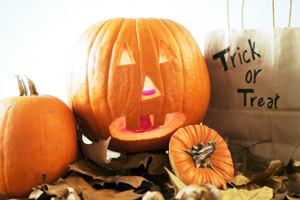Just in case you haven’t noticed the store displays that have been up since July, Halloween is just around the corner. And if the prospect of ghosts and goblins at the front door isn’t scary enough for you, how about the prospect of those same ghosts and goblins darting out from between cars into the street?
The combination of cars, kids and darkness presents the biggest danger of Halloween, and that combination could be even more dangerous this year, says Bo Kennedy, MD, professor of pediatrics at Washington University in St. Louis.

At this time of year it gets darker earlier, and on Halloween, excited, costumed children can be difficult to see, especially when excited adults and teenagers are off to their own celebrations.
Kennedy, who works in the emergency department at St. Louis Children’s Hospital, says over the years, some parents have worried about poison candy or razor blades in apples, but tampering with treats is extremely rare.
“We worry about poison candies and razor blades in apples and things like that make the public awareness frequently,” says Kennedy. “But the real danger is from cars striking the children as they’re running about the streets. It’s a very difficult situation for everybody, especially if the weather is bad and if it’s raining.”
Common-sense steps
Kennedy says the staff in the emergency department at St. Louis Children’s Hospital will almost certainly see a few kids this year who have been hit by cars. But parents and children can take some common-sense steps to avoid these potentially tragic injuries.
“The darkness is a big problem with Halloween, and carrying flashlights is probably the most important way to help children be seen by the cars, as well as enable them to see where they’re going,” says Kennedy.
“Additional things that are really important are brightly colored or reflective costumes and masks that don’t cover the eyes. In fact, it’s much better to paint the face with cosmetics than it is to cover with a mask that may prevent the children from seeing where they’re stepping or where they’re running.”
Kennedy says those who turn on the porch light and hand out treats also need to keep children safe. Jack-o’-lanterns shouldn’t be placed on the ground in areas where children might be and where capes or other parts of flowing costumes might come into contact with an open flame.
“Another problem that we have to worry about are pets,” adds Kennedy. “People have to make sure that their dogs are kept out of the way. This is a time when lots of strangers are coming around, as far as the pets are concerned, and the potential for dog bites is very real.” It might be a good idea to keep the dog in the basement or in the back of the house for a few hours, he suggests.
Too much candy also can be a problem, but Kennedy says the ensuing stomachache usually passes relatively quickly.
Of course, it doesn’t become an issue at all if adults monitor the candy and make sure their children don’t stuff themselves. He says parental supervision is one of the keys to a safe Halloween.
“The best thing is to have your children go into neighborhoods that you know, where you know the families and where the parents are with them as they’re walking from door to door,” he adds.
Kennedy also says that children need to stay out of the street and only cross at corners and designated crosswalks. Even a careful driver may not be able to stop if a child darts into the street from between cars.